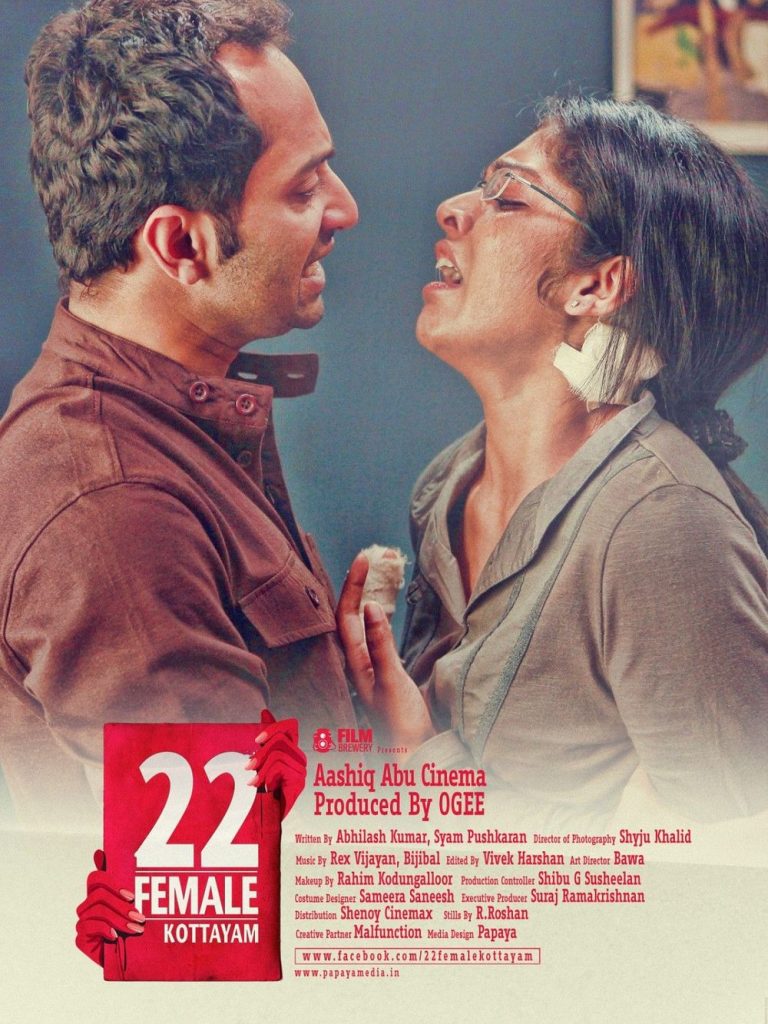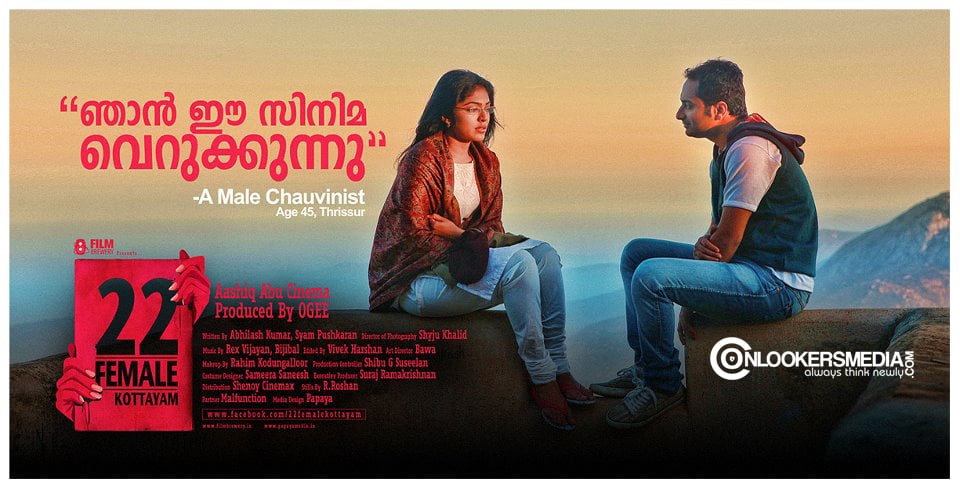Trigger warning: sexual violence
In the ending sequence of the film 22 Female Kottayam, as Tessa K. Abraham (Rima Kallingal) throws away the sim cards from her cellphone while on her way to Canada, a voiceover presents us with a didactic message: “This is not just the story of a girl who was repeatedly cheated. Tessa K. Abraham is a reminder. A reminder that a woman’s endurance is not her weakness.” With this very moral, we get an idea of who Tessa exactly is: a protagonist who has to endure suffering to emerge as strong.
You have seen countless women like her in films and pop culture: the woman who seeks vindication after being subjected to the uttermost dehumanisation, whose strength becomes her middle name. In other words, she is the archetype of the ‘strong female lead’: the determined, silent woman, who has a dark, troubled past, the no-nonsense type woman who is taciturn and hardened over time—the one who doesn’t bat an eyelid when she slashes the criminals or gets drenched in a shower of blood. She is strong, and that is her only defining personality trait. Her strength is all that matters.
Ironically, rape-thrillers are considered to be a subgenre of what David Edelstein termed ‘torture porn’. They are no less different than the rape videos that trend on pornographic sites.
Sounds familiar? Yes, she is Bride from Kill Bill or Jennifer Hills from I Spit On Your Grave. Closer home, you have Aarti Verma from Khoon Bhari Maang.
Moreover, that is precisely what undercuts the vein of 22 Female Kottayam by Aashiq Abu. It is another name in the long history of thriller movies that involve the female protagonist, acted by Rima Kallingal, avenging the sexual violence committed upon her by an equally sadistic mode. So, what exactly did Aashiq Abu differently portray on-screen? Nothing. Like all the other films, it has this subtle warning ringing at the back of the audience’s mind: a woman should always be chaperoned and escorted by a trustworthy person. In this film, the message is even worse: a woman living in with a man, as a couple brings peril upon herself.
Also read: Gender & The Shaping Of New Sensibilities In Malayalam Cinema
A Graphic Portrayal of Rape On-Screen
Tessa, aged 22, a female nurse from Kottayam, decides to live-in with Cyril (Fahadh Faasil), a guy from a travel consultancy agency which is arranging for her visa to Canada. One day, when she comes home from work, Cyril’s boss Hegde (Prathap K. Pothen), arrives and rapes her after a blunt question: Can I have sex with you? Without heeding to Tessa’s refusal and her attempts to dissuade him, he grabs her, molests her, knocks her out with an earthen flower pot when she retaliates, and then drags the half-conscious Tessa to the bedroom and rapes her.
In the entire sequence, the camera shifts in a series of jarring shots alternating its focus from the hands and abdomen of Hegde to Tessa’s behind, focusing on minute graphic details like the hitching of the nurse’s attire to blood spurting out and wetting her. In the bedroom sequence, the camera rests entirely upon Tessa’s face, capturing every change of expression, the writhing and twisting in pain, with Hegde’s assaulting hands only in focus.

It is a horrifying sequence, to say the least. Survivors of similar abuse, including myself, have flinched and even tried to fast forward through the scenes. It curdles your blood not with any supernatural elements but by the sheer force of violence. Which brings the question to your mind: Is it necessary to graphically portray such violence on-screen? In an article in the New York Times, Amanda Hess speaks about rape-revenge thrillers as being misappropriated as ‘cult vehicles for nihilistic gore’, albeit she labels them as ‘exploitation thrillers’.
She brings a crucial angle of these films to the table—they might employ rape and revenge as simply narrative devices to capitalise on sexual violence, followed by killing and still being able to ride the high horse of morality. The recovery process is almost ignored, if not completely omitted. I will add another angle to her critique: namely, that of sadistic scopophilia.
What does scopophilia mean? Sigmund Freud defined this as the pleasure or sexual gratification derived by gazing or looking at a sexualised object, such as a naked body or pornography. Sadistic scopophilia is its subset, and it implies voyeuristic pleasure gained from watching the object of your pleasure experiencing pain and undergoing violence.
Also read: Relic Film Review: The Psychological Horror Explores Grief, Trauma & Mental Health
Laura Mulvey employs the term ‘scopophilia’ in her essay, Visual Pleasure and Narrative Cinema, to explain the cinema’s function in fulfilling the pleasure purpose for the audience and its purpose of letting the audience narcissistically identify with the sexually objectified character. She dissects this pleasure principle of the viewer into ‘scopophilic’ and ‘active scopophilia’.
‘Scopophilic’ connotes the visual pleasure derived from exploiting another individual for sexual satisfaction and desire stimulation. The graphic depiction of Tessa’s rape in the film belongs to this category. Such scenes can only nurture rape fantasy in the audience and trigger trauma in survivors of similar violent crime. Violence is constantly eroticised, and after a point of time, the camera becomes synonymous with the heteronormative ultra-masculine gaze – the female victim is objectified and dissected under the scrutinising gaze of the male onlooker.
The rape sequence is disturbingly detailed and lengthened, and the focus on Tessa’s expressions adds a rather softcore pornographic appeal to the visuals. Ironically, rape-thrillers are considered to be a subgenre of what David Edelstein termed ‘torture porn’. They are no less different than the rape videos that trend on pornographic sites. The moment the news of such assault makes the headlines, the searches on Pornhub immediately show an utter curiosity to watch and gain pleasure from the gore and violence. Rape fantasy and masturbating to rape videos or rape scenes is a common albeit problematic trait among netizens. A quick search on the internet revealed this Quora thread about gaining pleasure from rape videos.
Also read: Bishorjan: The Dangerous Essentialism In The National Award Winning Film
What can we make of it? The fact that in a country where mainstream media only entertains sexual violence and objectification of the gender minority, whether subtly or overtly, where people imitate the reel in real life, and videos of sexual abuse (trending of Kathua rape case videos on PornHub) are highly viewed on pornographic sites, such portrayal needs to be avoided so as not to feed further ideas into the minds of potential or notorious perpetrators.
However, the problematic narrative of the film does not end here. I will recourse to Mulvey again, this time justifying my claims with her second category of pleasure principle: ‘active scopophilia’.
Revenge Of The Wronged Female—The Vindictive Victim Trope
Mulvey has defined ‘active scopophilia’ as the identification of the ego with the object on-screen through the spectator’s fascination with and recognition of his like. Such scopophilia can be a driving force for the particular mode of revenge depicted on screen.
In the film, it is revealed that Cyril was a pimp who lured in women for the satisfaction of his boss, Hegde. On the two occasions that Hegde raped Tessa, he had maintained his absence so as not to cause any doubt. He even plants a bag of cocaine in Tessa’s bag when she plans revenge on Hegde with him to save both his and his boss’s back. Tessa gets to know Cyril’s motives only when she is in jail, as a fellow inmate informs her about Cyril’s past crimes. Hegde is strangled with a snake, while Cyril is seduced and then penectomised under heavy sedation.
The second revenge is highly problematic because it shows that the protagonist too resorts to a form of sexual violence and manipulates the castrated man’s consent to assault him and avenge her trauma. Such revenge mode only acerbates the unwritten patriarchal norm that violence can only be avenged with violence.
The portrayal of violence on screen ought to be more nuanced, especially when it is sexual, and the site of violence is the living human body, be it any gender.
It is an extension of the rape rhetoric that is so prevalent after news of sexual violence makes the headlines – the seething public either vows to rape the rapist’s female relatives or to inflict such gruesome violence on him that he will learn a lesson of a lifetime and the scenes of revenge are vividly depicted. Moreover, the fact that it is directed by a man and scripted by two more men brings another angle of the male gaze to it—as I Spit On Your Grave, is it just another narrative that channelises the male fantasy and the male ideal of justice that can only be attained through violence.
Also read: What Does Feminist Film Theory Say?
However, the director decides to keep the act of castration in the background: unlike Tessa’s rape, Cyril’s penectomy is only implied through visuals of him in post-surgery pain and an IV bag connected to his bed. Furthermore, the fact that Cyril does not repent for his crimes, but tries to justify it, citing his traumatic childhood when his mother shared a similar fate with Tessa, only shows that the revenge method does not provide a cathartic experience: the rapist still does not realise the gravity of his crime. He sees this as a jab at his masculine pride, the castration being a denial of his manhood; hence he will take his own revenge on Tessa, and a vicious cycle is formed.
Let us consider the moral of the film in the light of sadistic scopophilia. We will see that 22 Female Kottayam cannot provide the necessary empowerment and catharsis to the audience that it seeks to do. The portrayal of violence on screen ought to be more nuanced, especially when it is sexual, and the site of violence is the living human body, be it any gender.
Further, it reinforces the narrative that a woman has to undergo severe physical abuse to be empowered and that empowerment is possible only if she can ‘seduce’ men as a non-conventional female. Rape revenge thrillers are prevalent narratives of sexual objectification through graphic violence sequences, and this directorial venture by Aashiq Abu is no exception.
Debadrita Saha is a postgraduate student of English literature at Presidency University, Kolkata. Her field of interests includes Gothic fiction, Bengali literature in the 19th century, postmodern literature, psychoanalysis, and gender studies. While she is not juggling between online classes and freelance content writing, she curls up with a good old tome or binges on Audrey Hepburn movies or her favourite TV show, Twin Peaks. She can be found on Facebook and Instagram.
Featured Image Source: Trying to be rational




